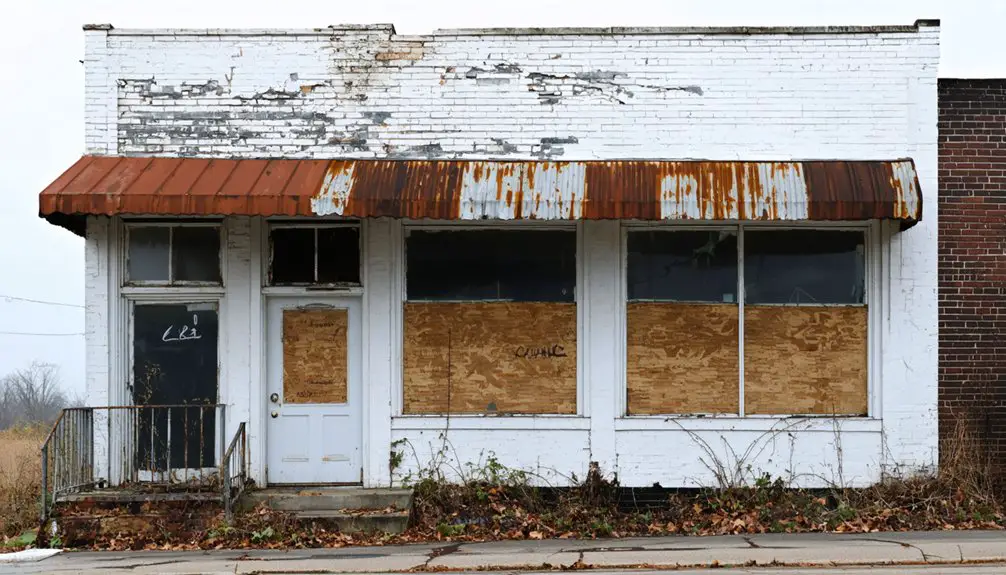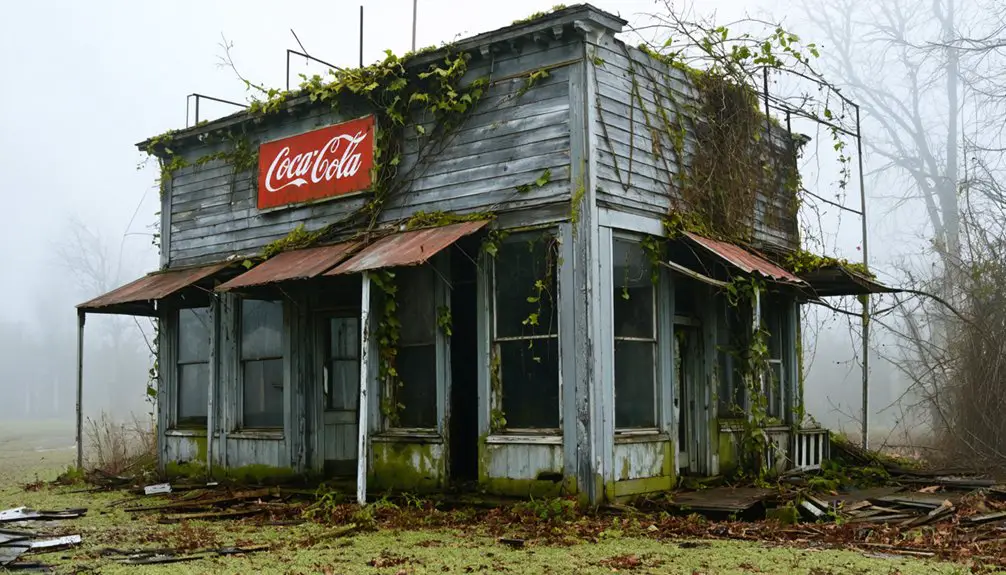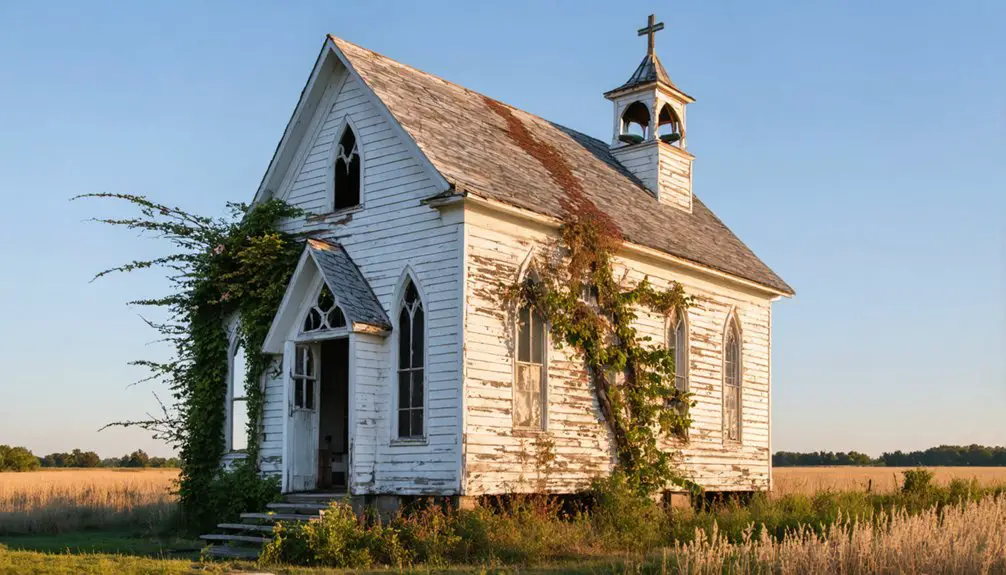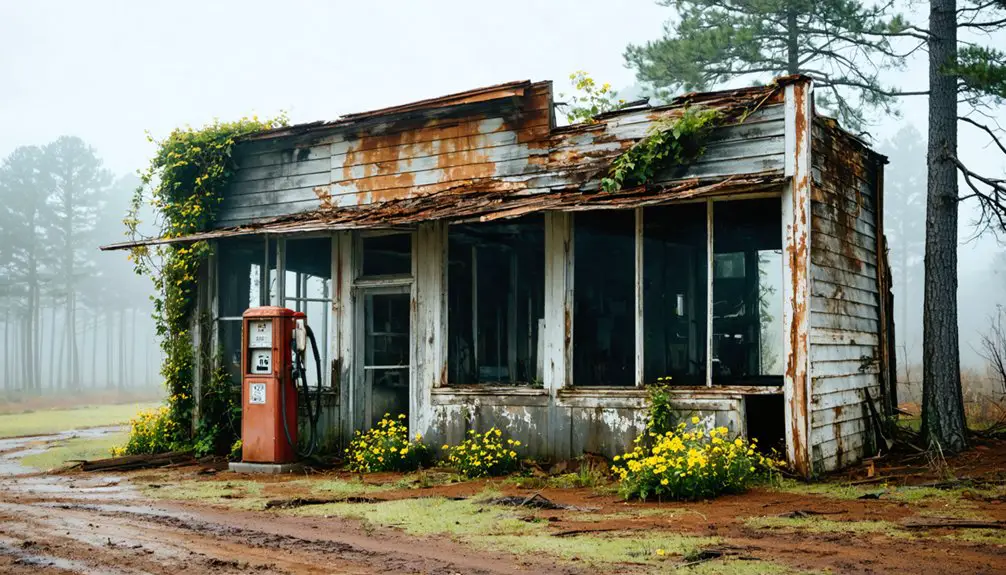You’ll find Inwood’s haunting ruins along Mississippi’s abandoned Yellow Dog Line, where a once-thriving agricultural hub now stands frozen in time. The town flourished in the late 1890s as an essential station stop, supporting cotton production and railroad commerce. By the mid-20th century, agricultural mechanization and shifting transportation patterns led to its decline. Today, empty streets, a 200-grave cemetery, and mysterious local legends tell stories of this lost Delta community.
Key Takeaways
- Inwood was established as a railroad town along the Yellow Dog Line in Mississippi during the mid-19th century railroad expansion.
- The town flourished through cotton agriculture and railroad commerce, serving as a vital distribution hub for Delta farmers.
- Local life centered around the train depot, with cotton merchants, lumber traders, and passengers gathering daily for business.
- Economic changes, agricultural mechanization, and declining rail transport led to Inwood’s abandonment in the 20th century.
- The ghost town features over 200 graves, abandoned structures, and reported supernatural activity including phantom sounds and mysterious apparitions.
The Rise of a Delta Railroad Town
While many Mississippi Delta towns emerged organically, Inwood’s establishment followed a calculated pattern typical of railroad-driven development in the mid-19th century. Railroad expansion swept through Mississippi, driven by the demands of the timber industry and the ambitious vision of Whig supporters seeking civic improvements. By 1900, the state had reached 2,788 miles of track, marking unprecedented growth in railway infrastructure.
You’ll find Inwood’s story mirroring that of other Delta settlements, where the placement of a depot determined the town’s fate. The Illinois Central Railroad, which connected New Orleans to Chicago by acquiring local lines in the 1870s, played a vital role in shaping these communities. Early timetables showed six daily trains passing through similar Delta towns, demonstrating the region’s bustling railway activity.
Like many rail towns, Inwood’s official recognition came after the establishment of its depot, followed by systematic lot sales that transformed raw land into an organized community designed to serve the railroad’s interests.
Life Along the Yellow Dog Line
If you’d lived in Inwood during its railroad heyday, you’d have witnessed the bustling activity around the Yellow Dog Line’s station, where cotton merchants, lumber traders, and passengers congregated daily.
The railroad station served as both an essential transportation hub and a social center, where locals gathered to exchange news and conduct business while waiting for trains.
Families and workers built their lives around the railroad’s schedule, as the Yellow Dog Line’s regular service connected their small Delta town to larger markets and opportunities throughout Mississippi.
The passenger service primarily carried lumber company employees and their families until operations ceased with the sawmill’s closure.
The area became known for its vibrant nightlife, as blues and jazz filled local juke joints where diverse crowds gathered on Saturday nights.
Railroad Station Life
Life along the Yellow Dog line centered around bustling railroad stations that served as essential hubs for both commerce and community.
You’d find station agents managing the daily flow of freight and passengers, while porters and laborers worked long hours handling cargo and maintaining the tracks. The station dynamics reflected the era’s complex labor relations, with workers often bound by “yellow dog contracts” that prevented them from joining unions.
You’d see modest worker housing clustered near the tracks, creating tight-knit communities where daily routines revolved around train schedules. Mail deliveries, cotton shipments, and passenger service kept these stations alive with activity. African-American blues musicians often sang about the Yellow Dog Railroad as a powerful symbol of escape and freedom. The line gained widespread recognition when W.C. Handy immortalized it in his 1914 composition, “The Yellow Dog Rag.”
For towns like Inwood, the station was more than just a stop – it was the heartbeat of local economic and social life.
Community Growth Era
During the early 1900s, the Yellow Dog Line transformed Inwood and neighboring Delta towns into thriving agricultural hubs. The railway’s impact on community dynamics sparked remarkable population shifts as farmers, laborers, and railroad workers settled near the stations. Much like Wikipedia’s disambiguation pages, the railway helped direct people to their intended destinations.
You’d have found vibrant social centers emerging around the tracks, where general stores and churches became gathering spots for residents. W.C. Handy’s first encounter with the blues in Tutwiler marked the line’s significance in music history.
The railway’s influence on Inwood’s growth was evident in three key areas:
- Agricultural expansion through efficient cotton and produce transportation
- Economic development from timber shipments and increased market access
- Cultural enrichment as seasonal workers and blues musicians moved through the area
The train schedule shaped daily life, with community events and markets timed to coincide with arrivals and departures, creating a distinctive rhythm to local activities.
Agricultural Heritage and Economic Foundation
If you’d visited Inwood in its heyday, you’d have seen cotton production dominating the landscape, with vast fields stretching outward from the Yellow Dog railroad line that served as the community’s lifeline for agricultural shipping.
The railroad’s strategic position made Inwood a crucial distribution point, connecting Delta farmers to broader markets and enabling efficient transport of their cotton crops to distant textile mills. Like many Delta communities, Inwood’s agricultural system relied heavily on sharecropping and tenancy arrangements that kept workers tied to the land through cycles of debt. Eight million acres of Mississippi land were sold through federal land sales between 1833 and 1836, fueling the region’s cotton economy.
The farming community’s daily rhythms centered around cotton’s demanding cultivation cycle, from spring planting through fall harvest, shaping both the economic foundations and social structures of this now-vanished Delta town.
Cotton Production Impact
As Mississippi’s agricultural landscape transformed in the early 1800s, cotton emerged as the economic powerhouse that would shape Inwood’s destiny.
The cotton history of the region reflected the broader agricultural revolution sweeping through Mississippi, where production skyrocketed from zero to 535 million pounds by 1860.
The economic implications of cotton’s dominance in Inwood were profound, as you’ll discover through these key developments:
- The introduction of Mexican seed cotton and Petit Gulf varieties dramatically improved local yields.
- Steam-powered cotton gins revolutionized processing capabilities.
- The plantation system established a complex economic structure that controlled land, labor, and tools.
You’ll find that cotton’s influence extended beyond mere agriculture, supporting the rise of antebellum infrastructure and shaping the entire social fabric of Inwood’s community.
Railroad Distribution Networks
The arrival of railroad networks in Mississippi marked a new chapter for Inwood’s cotton-driven economy.
You’ll find that railroad expansion transformed the region’s agricultural landscape, with over 4,000 miles of track laid across the state. The Illinois Central Railroad and its subsidiaries, particularly the Yazoo & Mississippi Valley line, created an intricate web of distribution efficiency that connected local farms to major markets in Memphis and New Orleans.
When you examine the economic foundations, you’ll see how these rail networks drastically reduced transportation costs while enabling farmers to diversify their operations.
The strategic placement of depots attracted essential infrastructure like cotton gins and warehouses, creating a seamless integration between agricultural production and processing. This thorough system supported Inwood’s growth until shifts in transportation methods led to the abandonment of various branch lines.
Delta Farming Community Life
Deep within Mississippi’s Delta region, Inwood’s agricultural heritage emerged from a complex system of cotton plantations that dominated the landscape throughout the 1800s.
You’ll find evidence of the region’s labor dynamics through remnants of plantation homes and slave quarters that still dot the countryside.
After the Civil War, you’d witness dramatic shifts in the agricultural system, with crop sharecropping becoming the new economic foundation.
Here’s how farming life transformed:
- Wealthy landowners maintained control through credit systems and crop liens
- Over 80% of farms shifted to sharecropping operations, mostly worked by African Americans
- Local stores trapped sharecroppers in cycles of debt through high-interest credit purchases
Despite technological advances in farming equipment, the Delta’s social and economic structure remained largely unchanged, preserving a system of agricultural dependency.
From Prosperity to Abandonment

During its peak in the late 1890s, Inwood flourished as a vibrant station town along the Yazoo Delta Railroad, serving as an essential commercial hub between Moorhead and Ruleville.
You’d have found a community deeply rooted in the Delta’s cultural significance, where cotton agriculture and railroad commerce drove local prosperity.
As the 20th century progressed, you would’ve witnessed Inwood’s gradual decline through economic changes that reshaped the Delta.
The shift away from rail transport, combined with agricultural mechanization, weakened the town’s purpose.
Natural disasters, including devastating floods, further threatened the community’s stability.
Multiple disruptions, from epidemics to fires, accelerated the exodus of residents toward larger urban centers.
Ghost Stories and Local Legends
While Inwood’s physical structures have largely crumbled away, its supernatural legacy continues to captivate visitors and locals alike. The town’s ghostly encounters span generations, with spectral legends rooted deeply in Civil War history and local tragedy.
- You’ll find unexplained phenomena throughout the three-acre cemetery, where over 200 graves harbor stories of mysterious apparitions and a notorious hanging victim’s spirit.
- You can explore the old jailhouse yard, known for its lynching victim’s restless presence and the bone-chilling cold spots that mark the location.
- You might witness the haunting echoes of Civil War conflicts, as visitors report phantom gunshots, cannon fire, and church bells ringing through the night.
These supernatural elements have become an integral part of Inwood’s preserved heritage, drawing curious explorers to its haunted grounds.
Photographic Journey Through Time
As you trace the photographic history of Inwood through time, you’ll discover a visual story that begins with the town’s establishment as a Yazoo Delta Railroad station in the 1890s.
While photographic documentation remains limited, available images would’ve captured the town’s railroad infrastructure, including the depot, loading docks, and “Yellow Dog” rail line at 131 feet above sea level.
The visual storytelling takes you through Inwood’s transformation from an active Delta rail stop to its eventual abandonment.
Through comparative analysis with similar ghost towns, you can piece together how this small settlement at 33°30′21″N, 90°31′29″W evolved.
The photographic significance lies in documenting the changing landscape, from bustling railroad activity to nature’s gradual reclamation of the site, revealing the Delta’s ever-shifting economic tides.
Legacy of Mississippi’s Lost Communities
Beyond Inwood’s abandoned rails and silent streets lies a broader story of Mississippi’s lost communities, where economic shifts, natural disasters, and changing transportation routes transformed once-thriving towns into haunting remnants of the past.
You’ll find a rich cultural heritage preserved in these ghost towns, where empty churches and overgrown cemeteries tell tales of communities that once buzzed with life.
- Abandoned structures serve as time capsules, revealing architectural styles and building methods of Mississippi’s prosperous era.
- Local cemeteries, with hundreds of weathered headstones, document family histories and demographic patterns.
- Economic decline patterns mirror broader historical forces, from epidemics to flooding, that challenged river towns’ survival.
These silent settlements aren’t just relics – they’re powerful reminders of how external forces can reshape communities’ destinies.
Frequently Asked Questions
What Was the Peak Population of Inwood During Its Most Prosperous Years?
While railroad towns typically housed 100-300 residents, you’ll find no documented peak population for this site of historical significance, though economic decline likely reduced numbers from modest railroad-era levels.
Are There Any Remaining Buildings or Structures Still Standing in Inwood Today?
You’ll find only a few abandoned structures still standing – mainly the Gothic Revival Baptist Church, Presbyterian Church, and Mt. Zion Baptist Church, each holding historical significance despite flood damage.
When Was the Last Known Permanent Resident Recorded in Inwood?
You can’t find definitive records of Inwood’s last resident due to limited historical documentation. While the town’s decline parallels other Mississippi ghost towns, the final inhabitant’s timeline remains undocumented.
What Businesses and Services Existed in Inwood Before Its Decline?
From bustling railroad commerce to silent streets, you’d have found general stores, banks, hotels, professional services, churches, and transportation-related businesses that once drove the local economy through the station.
Does Inwood Have a Cemetery, and if So, Is It Still Maintained?
You’ll find the Travelers Rest Church Cemetery in the area, though its historical significance is limited. There’s no documented evidence of active cemetery maintenance, unlike other nearby ghost town burial grounds.
References
- https://sethparker.net/rodney-mississippi-the-ghost-town-youve-probably-never-heard-of/
- https://theforgottensouth.com/rodney-mississippi-ghost-town-history-tour/
- https://mississippifolklife.org/articles/haunted-by-a-ghost-town-the-lure-of-rodney-mississippi
- https://en.wikipedia.org/wiki/Inwood
- https://backroadplanet.com/haunting-rodney-mississippi/
- https://mississippiencyclopedia.org/entries/railroads/
- https://www.custermen.com/Cole/YMVRR.htm
- https://hawkinsrails.net/shortlines/cagy/cagy_western.htm
- https://hawkinsrails.net/shortlines/cagy/cagy_eastern.htm
- https://www.msrailroads.com/Towns/Moorhead.htm



